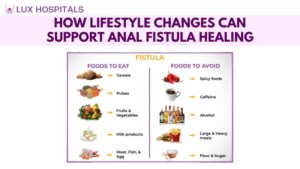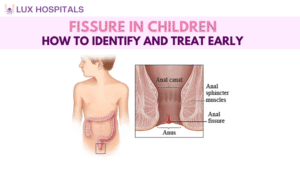“Breakthrough Treatments for Rectal Prolapse: Minimally Invasive Options”

Rectal prolapse is a condition that can significantly affect one’s quality of life. This debilitating issue, characterized by the protrusion of the rectum through the anus, can cause discomfort and impact daily activities. Traditional treatments for rectal prolapse have been effective in managing symptoms, but advances in medical technology have introduced innovative, minimally invasive options that offer promising results. This blog explores these modern treatments for rectal prolapse, emphasizing their benefits over conventional methods and providing a comprehensive overview of the latest advancements in treatments for rectal prolapse.
1. Understanding Rectal Prolapse
Rectal prolapse occurs when the rectum, the last part of the large intestine, slips out of its normal position and protrudes through the anus. This condition can vary in severity, from a partial prolapse where only the inner lining of the rectum protrudes, to a full-thickness prolapse where the entire rectal wall comes outside the anus. Understanding rectal prolapse is crucial for exploring effective treatments for rectal prolapse.

Symptoms of Rectal Prolapse
Common symptoms of rectal prolapse include:
- Visible Protrusion: The rectum appears outside the anus.
- Rectal Bleeding: Presence of blood or mucus discharge.
- Discomfort or Pain: Pain in the rectal area.
- Incontinence: Difficulty controlling bowel movements.
- Sensation of Lump: A feeling of pressure or a lump in the rectum.
Causes and Risk Factors
Rectal prolapse develops as a result of several factors, such as:
- Chronic Constipation: Straining during bowel movements can weaken the pelvic support structures.
- Pelvic Floor Weakness: Weakness in the muscles supporting the pelvic organs.
- Aging: Weakened connective tissues and muscle atrophy due to aging.
- Childbirth: Vaginal delivery, especially multiple births, can weaken pelvic muscles.
- Previous Rectal Surgery: History of rectal surgeries may increase the risk of prolapse.
2. Traditional Treatment Options for Rectal Prolapse
Traditional treatments for rectal prolapse include:
- Surgical Procedures: Conventional surgery often involves repairing the prolapsed rectum through open surgery. Techniques such as rectopexy (securing the rectum to the surrounding tissues) or resection (removing a portion of the rectum) are commonly used.
- Lifestyle Changes: Managing constipation through dietary changes, increased fiber intake, and stool softeners can help reduce symptoms of rectal prolapse.
- Pelvic Floor Exercises: Strengthening exercises may help improve muscle support in mild cases of prolapse.
Limitations of Traditional Treatments
While effective, traditional treatments come with drawbacks:
- Invasive Nature: Open surgeries involve significant incisions and longer recovery times.
- Extended Recovery Periods: Patients often face longer hospital stays and prolonged recovery periods.
- Risk of Complications: Higher risk of postoperative complications, such as infections and wound healing issues.
3. Minimally Invasive Treatment Options for Rectal Prolapse
Minimally invasive treatments for rectal prolapse offer numerous advantages over traditional methods. These approaches involve smaller incisions or non-surgical techniques, which can result in reduced recovery times, less pain, and minimal scarring. Let’s explore some of these innovative treatments for rectal prolapse.
A. Laparoscopic Surgery
Laparoscopic surgery, also known as keyhole surgery, uses small incisions and specialized instruments to perform the procedure. A laparoscope, a thin tube with a camera, allows surgeons to view the rectum and surrounding tissues on a monitor.
Procedure
For rectal prolapse, laparoscopic surgery typically involves:
- Identifying the Prolapsed Rectum: The laparoscope helps visualize the rectal prolapse.
- Securing the Rectum: Surgeons may use sutures or mesh to secure the rectum in its proper position.
- Minimally Invasive Approach: Small incisions are made, through which the laparoscope and surgical instruments are inserted.
Benefits
- Reduced Recovery Time: Patients generally experience shorter recovery periods compared to open surgery.
- Minimal Scarring: Less obvious scarring results from smaller incisions.
- Less Pain: Minimal tissue disruption results in reduced postoperative pain.
Success Rates
Recent studies show that laparoscopic surgery for rectal prolapse has high success rates. Many patients experience significant improvement in symptoms and quality of life. The minimally invasive nature of this approach contributes to faster recovery and lower rates of complications.
B. Endoscopic Techniques
Endoscopic techniques, such as transanal endoscopic microsurgery (TEMS), involve using a specialized endoscope to perform the procedure from within the anus. This approach is particularly effective for treating rectal prolapse.
Procedure
- Inserting the Endoscope: The endoscope is inserted through the anus to visualize the prolapsed rectum.
- Resecting the Prolapsed Tissue: Surgeons can remove or repair the prolapsed tissue using instruments passed through the endoscope.
- Minimally Invasive Approach: The procedure is performed through the anus, avoiding external incisions.
Benefits
- Less Invasive: No external incisions are required, reducing surgical trauma.
- Quicker Recovery: Patients often experience a faster return to normal activities.
- Reduced Discomfort: Minimal disruption to surrounding tissues results in less postoperative discomfort.
Success Rates
Endoscopic techniques, including TEMS, have demonstrated high success rates in managing rectal prolapse. Patients benefit from a less invasive approach and experience improved outcomes with minimal complications.
C. Robotic-Assisted Surgery
Robotic-assisted surgery utilizes robotic systems to enhance the precision of surgical procedures. Surgeons operate robotic arms that are fitted with specialized tools and high-definition cameras.
Procedure
- Robotic System Setup: The robotic system is set up to assist the surgeon in performing the procedure.
- Performing the Surgery: Surgeons use the robotic arms to perform delicate tasks with enhanced precision.
- Securing the Rectum: The prolapsed rectum is repaired or secured using robotic assistance.
Benefits
- Enhanced Precision: The robotic system provides improved control and accuracy.
- Shorter Hospital Stays: Patients often experience reduced hospital stays and quicker recovery.
- Less Pain and Scarring: The minimally invasive nature of the procedure leads to less pain and scarring.
Success Rates
Robotic-assisted surgery for rectal prolapse has shown excellent results, with high success rates and positive patient outcomes. The precision of robotic systems contributes to effective treatment and minimal postoperative issues.
D. Biofeedback Therapy
Biofeedback therapy is a non-invasive treatment that helps patients learn to control physiological functions, such as muscle contractions. This therapy is used to strengthen the pelvic floor muscles and manage symptoms of rectal prolapse.
Procedure
- Biofeedback Training: Patients receive training to monitor and control muscle activity using sensors and feedback devices.
- Strengthening Exercises: Exercises are prescribed to improve pelvic floor strength and function.
- Ongoing Monitoring: Regular sessions help track progress and adjust treatment as needed.
Benefits
- Non-Invasive: No surgical intervention is required.
- Improves Muscle Control: Strengthens pelvic floor muscles, which can alleviate symptoms of rectal prolapse.
- Holistic Approach: Addresses both the physical and functional aspects of prolapse management.
Success Rates
Biofeedback therapy has been shown to be effective in managing symptoms of rectal prolapse, particularly in improving muscle control and function. It offers a valuable adjunct to other treatments and helps patients achieve better outcomes.
4. Comparing Minimally Invasive Treatments for Rectal Prolapse
When choosing a minimally invasive treatment for rectal prolapse, consider the following factors:
- Recovery Time: Evaluate the expected recovery period for each treatment option.
- Effectiveness: Assess how well each treatment addresses the prolapse and improves symptoms.
- Patient Preference: Consider patient comfort, preferences, and lifestyle when selecting a treatment.
Patient Testimonials
Including patient testimonials can provide valuable insights into the experiences of individuals who have undergone minimally invasive treatments for rectal prolapse. These real-life accounts highlight the benefits and potential challenges of each treatment option.
Expert Opinions
Consulting with healthcare professionals and specialists provides additional perspectives on the best practices and recommendations for treating rectal prolapse. Experts can offer guidance based on individual patient needs and medical advancements.
5. Preparing for Treatment
Before undergoing treatment for rectal prolapse, it is essential to consult with a specialist to determine the most suitable option for your condition. A thorough evaluation and discussion of treatment options will help ensure the best possible outcome.
Pre-Treatment Considerations
- Medical History: Share your medical history and any relevant health information with your healthcare provider.
- Preparation: Follow any pre-treatment instructions provided by your specialist to ensure a smooth procedure.
Post-Treatment Care
- Follow-Up Appointments: Attend follow-up appointments to monitor progress and address any concerns.
- Care Instructions: Adhere to post-treatment care instructions, including any recommended lifestyle changes or physical therapy.
6. Conclusion
Innovative treatments for rectal prolapse offer promising alternatives to traditional methods. Minimally invasive options, such as laparoscopic surgery, endoscopic techniques, robotic-assisted surgery, and biofeedback therapy, provide numerous benefits, including reduced recovery times, minimal scarring, and improved patient outcomes. By exploring these modern treatments for rectal prolapse, patients can achieveeffective relief and enhance their quality of life.
If you or a loved one is struggling with rectal prolapse, we encourage you to consult with a specialist at Lux Hospitals. Our experts are equipped to guide you through the latest treatments for rectal prolapse and help determine the best approach for your specific condition.




















